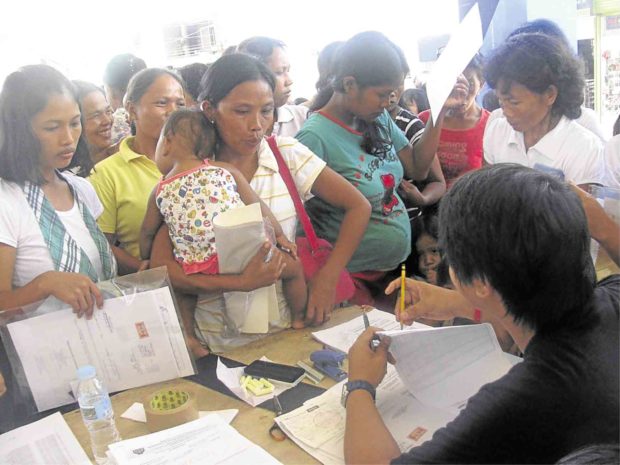4Ps under Duterte still needs to evolve from ‘mere dole’

Credit to Author: racosta| Date: Fri, 19 Jul 2019 21:45:40 +0000
Thanks to the Pantawid Pamilyang Pilipino Program (4Ps), Yolanda Mendoza, finally had enough pocket money to treat herself and her family to a few burgers. She stepped into a fast-food joint as a paying customer for the first time—at age 40.
“I used to always say no to my children. Now I can buy them what they want, as long as we have the budget,” said Mendoza, who grew up dirt poor in Pasuquin town, Ilocos Norte province, relying on seasonal farm work until she qualified under the government’s 4Ps five years ago.
Monthly financial assistance
Married with two kids, she used to run a “sari-sari” store, whose capital she managed to raise from the monthly financial assistance she started receiving during the Aquino presidency and continued to enjoy under the three-year-old Duterte administration.
By institutionalizing 4Ps, the Duterte administration has ensured the continuation of the conditional cash transfer program intended to uplift the living conditions of the poorest of the poor.
The program was introduced by then President Gloria Macapagal-Arroyo and was expanded under President Benigno Aquino III.
Gov’t mandate
Signed into law by President Duterte in April, Republic Act No. 11310 makes the 4Ps a permanent government program that will benefit from yearly allocations from the General Appropriations Act. The Department of Social Welfare and Development (DSWD), the project’s lead agency, expects to complete the implementing rules and regulations (IRR) of the new law by December.
There are 4.186 million households enrolled in the program as of this month, DSWD spokesperson Irene Dumlao said, adding that the department was working to enroll an additional 214,000 households by 2020 to reach its target of 4.4 million.
The DSWD chooses household beneficiaries using a standardized National Household Targeting System for Poverty Reduction, or the Listahanan. The bottom line is that beneficiary-households are cash-poor and must have children from 0 to 18 years of age. They must also agree to meet the conditions set by the program, in which a maximum of three children per household can be enrolled.
“At present, a family beneficiary can get a maximum of P2,900 per month,” Dumlao said.
With the completion of the IRR, the cash grants will increase from P300 to P500 for every child enrolled in junior high school, and from P500 to P700 for every child enrolled in senior high school. Health grants will also increase from P500 to P750, Dumlao said.
No livelihood programs
But a public policy expert believes that the 4Ps is still lacking in subsistence programs that can adequately lift a family from poverty.
Dean Maria Fe Mendoza of the University of the Philippines’ National College of Public Administration and Governance (UP NCPAG) noted the lack of livelihood programs for family heads, which, she said, could encourage beneficiaries to merely wait for doles.
“Our expectation is that this will remain a dole-out program. It has no livelihood component, and is not a holistic social program,” Mendoza said.
She said that since the 4Ps was now a regular program, with a regular allocation, it should be expanded to become holistic and ultimately meet the promise of making poor families independent
Mendoza said that in crafting the IRR of the new law, the DSWD and other concerned agencies should ensure that beneficiaries would be made aware that they could, and should, seek other sources of income even while receiving the cash grants. “This will prepare them for independence once they graduate or age out of the program,” she said.
Self-reliance
In 2016, during his first State of the Nation Address, President Duterte promised that 4Ps beneficiaries would have become independent and self-reliant after graduating from the program. He said they would be provided other forms of assistance so that they would ultimately be able to stand on their own feet.
Dumlao said that while under the new law, beneficiaries “shall be given priority” in availing themselves of the DSWD’s Sustainable Livelihood Program (SLP), the 4Ps would remain a cash transfer program, and beneficiaries must seek other poverty alleviation programs on their own.
‘False dependence’
But the UP NCPAG’s Mendoza said the SLP should be integrated into the 4Ps. The DSWD, she said, could do more to make sure that beneficiaries understand the scope and limitations of the 4Ps. She also pointed out that some beneficiaries were not seeking supplemental income for fear of being removed from the program.
“This could promote false dependence,” she said. “It’s not clear to beneficiaries that they are allowed to and are even encouraged to look for additional work, since the cash grant on its own is not enough to sustain a family.”
According to Mendoza, the danger of failing to transform the 4Ps into one of holistic social protection is that it can foster dependence and helplessness—the complete opposite of what the government hopes for the program beneficiaries.